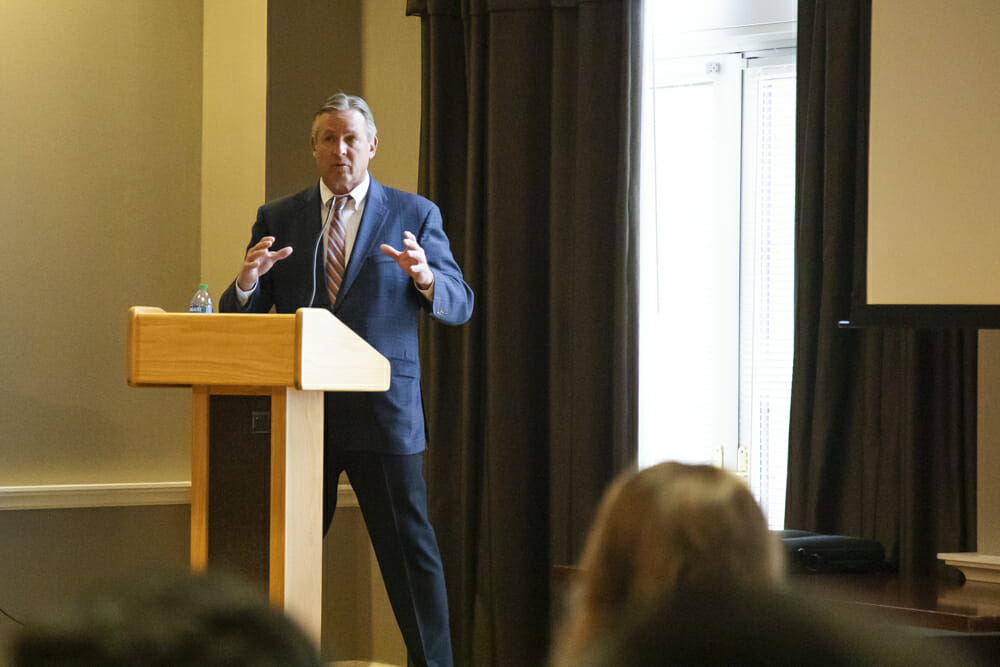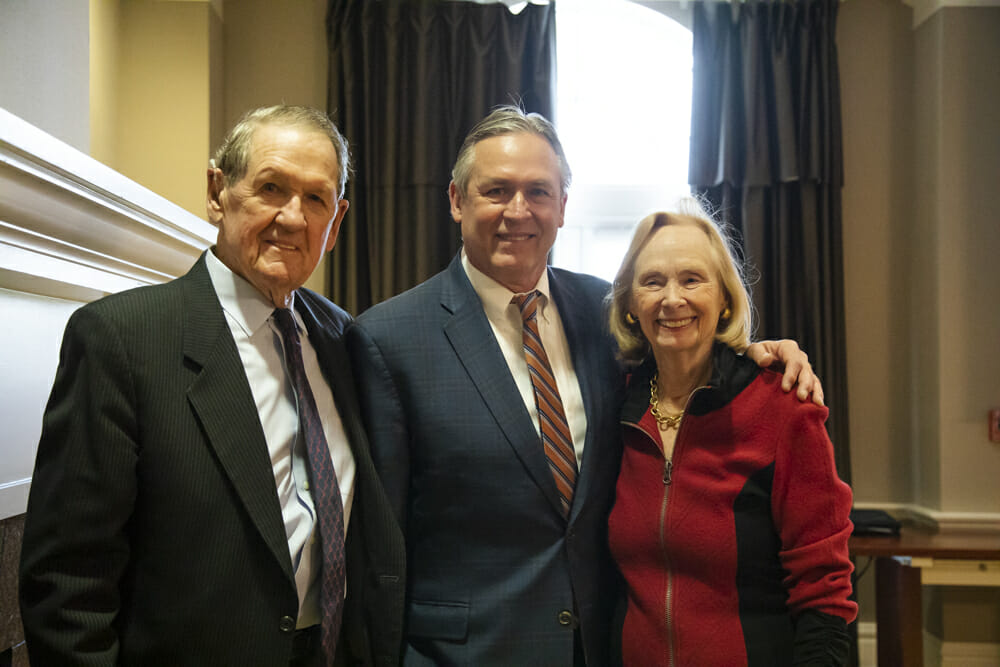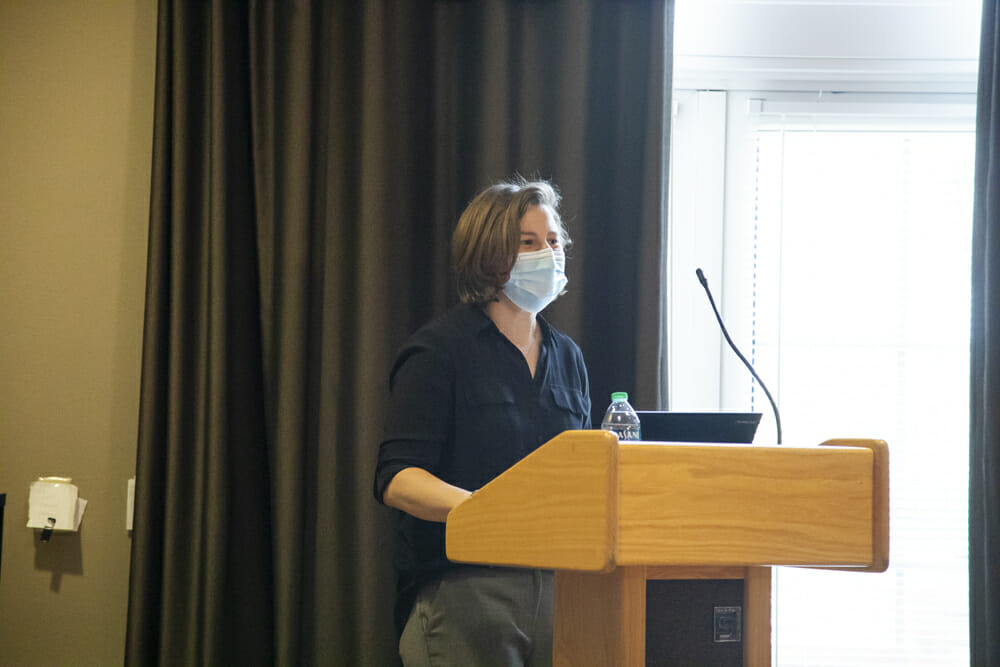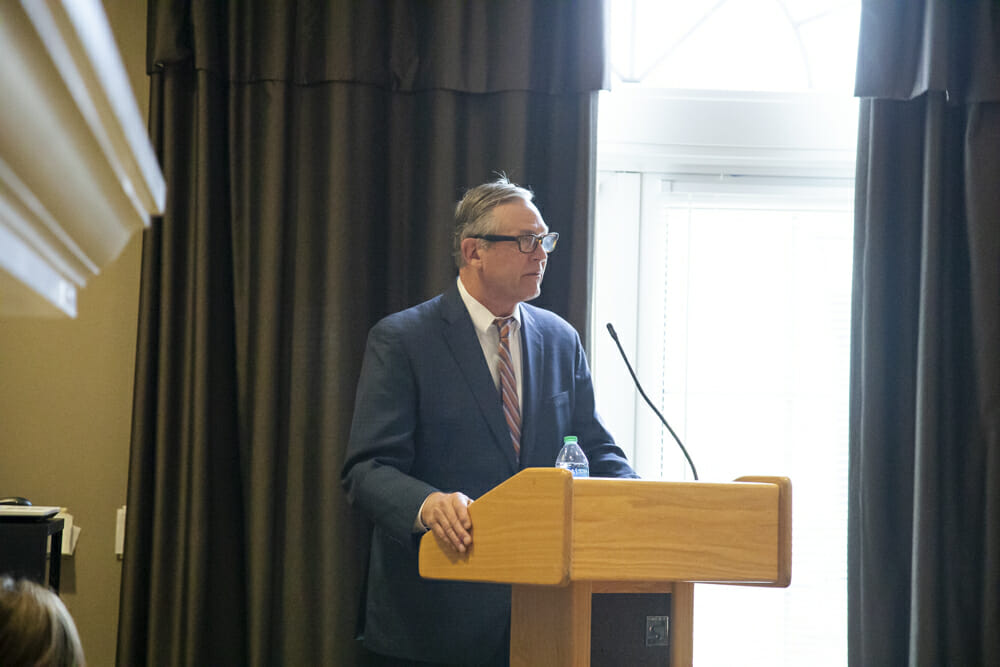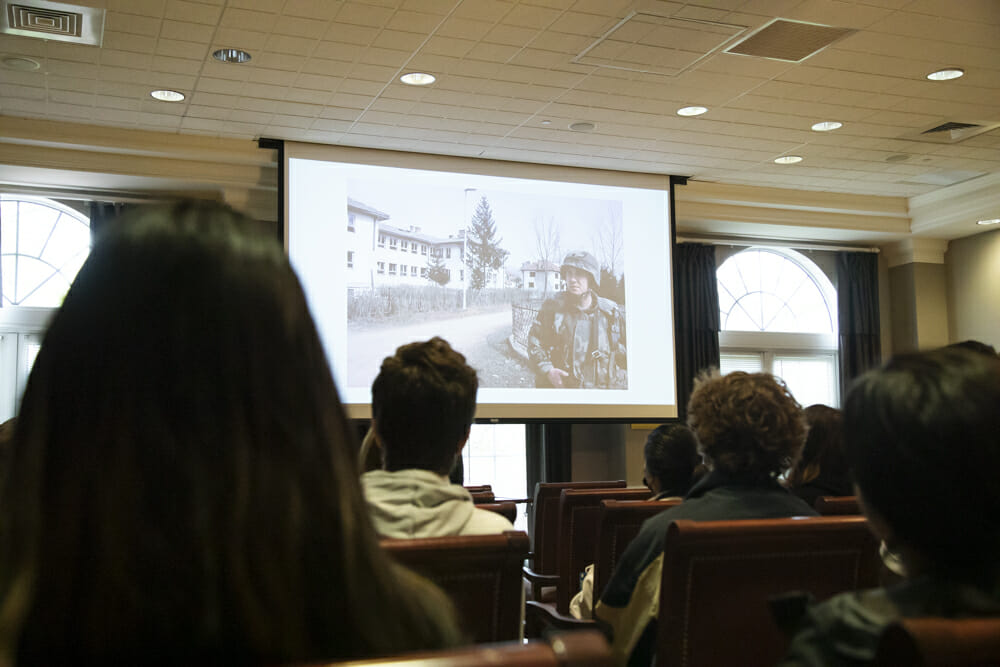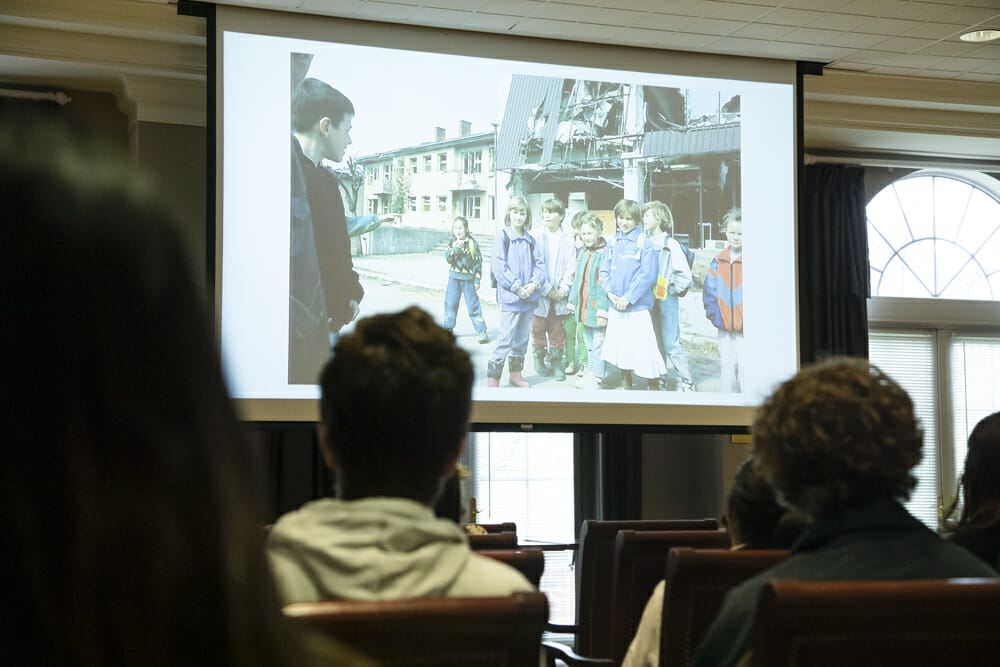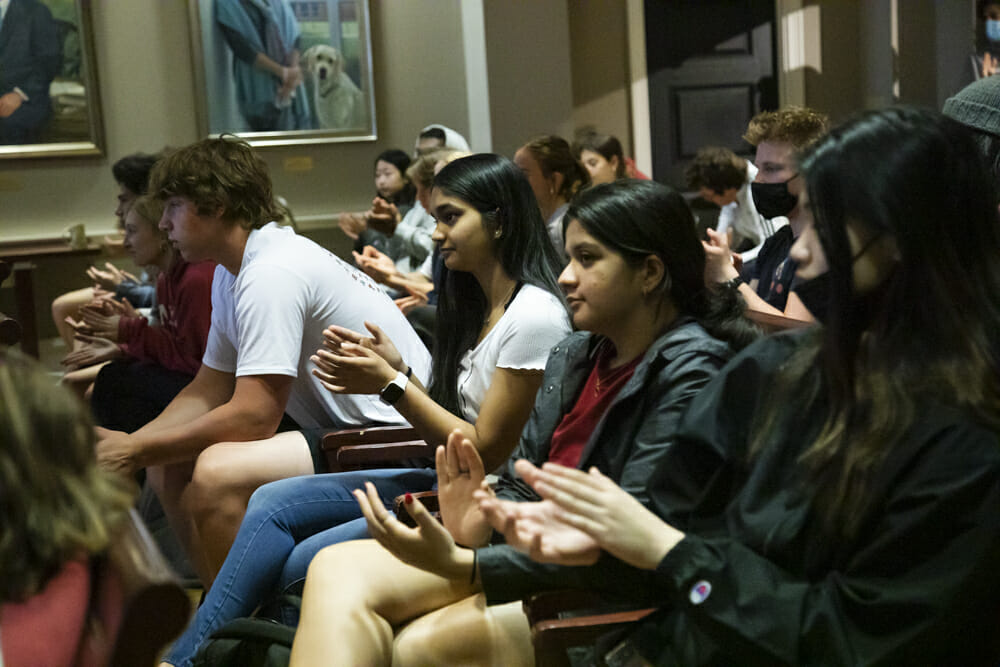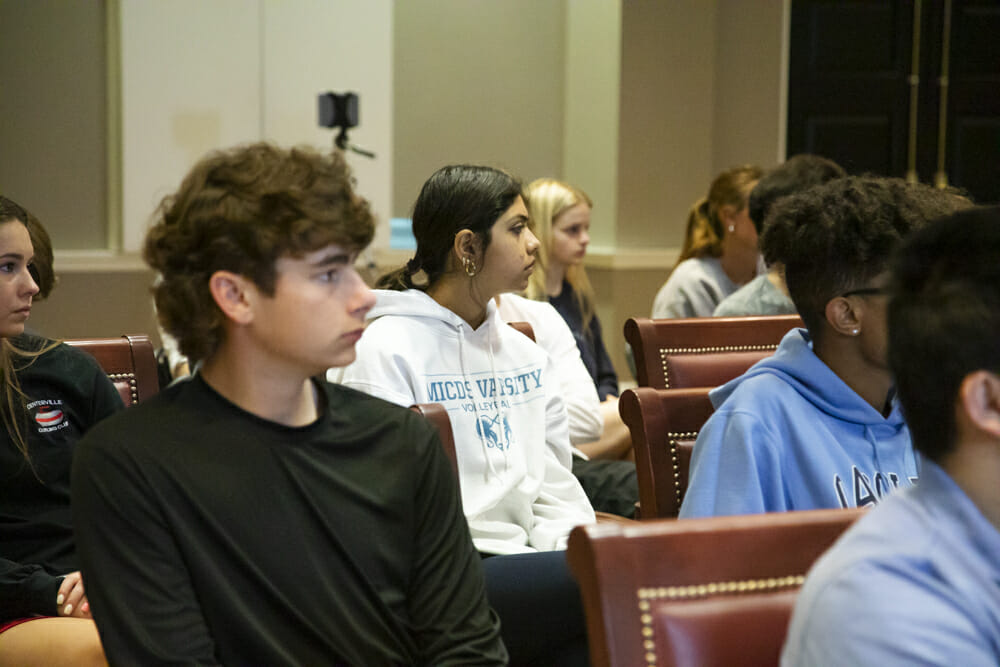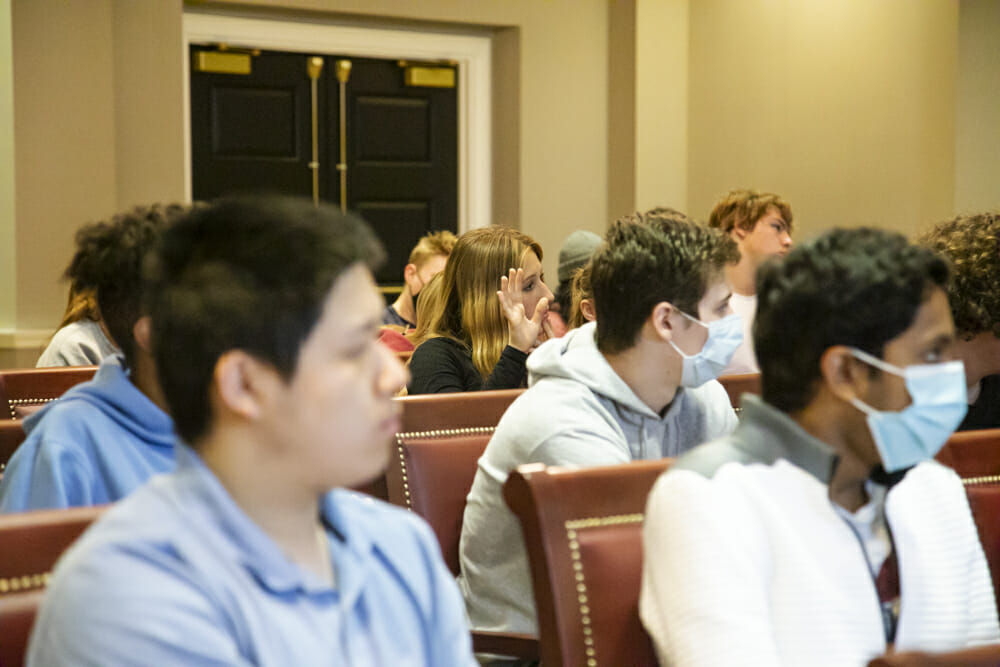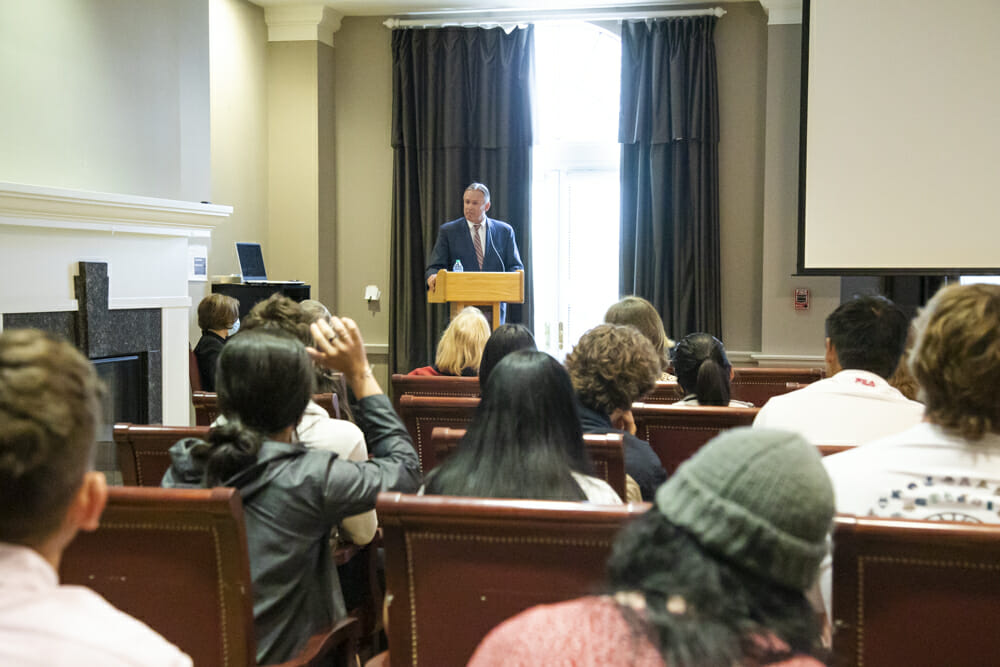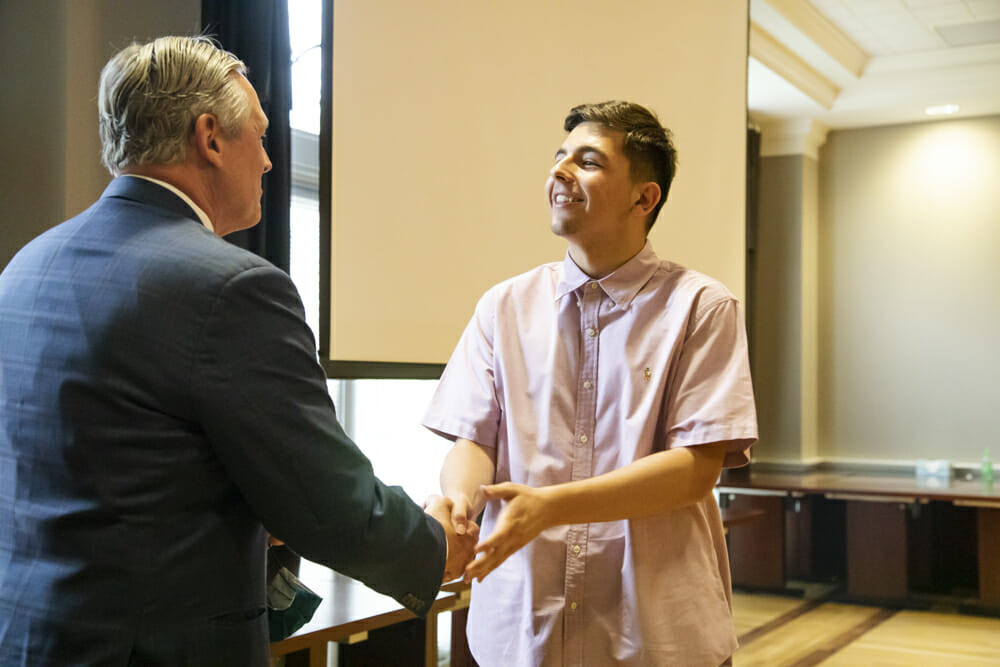In the Upper School Human Rights & Genocide history elective for juniors and seniors, students had the opportunity to hear from alumnus Bill Wallace ’78 who shared his first-hand perspective as a UN and NATO Peacekeeper to Bosnia in 1995 and 1996. The class had just recently wrapped up a unit on the former Yugoslavia, focusing on the civil wars and crimes against humanity in the early 1990s.
Wallace is a Special Operations Army Veteran, having served in the United States Army from 1991 to 1999 with deployments to Panama and Bosnia. When he was a UN and NATO Peacekeeper to Bosnia, part of his duty was with the NATO Special Operations Documentary Team where he provided transportation and security for the cameraman, producer, and interpreters. In addition, he has an extensive history of working with veteran-specific issues as a case manager in the Veterans Administration, as a clinical director at U.S. VETS – Long Beach and U.S. VETS – St. Louis, and he founded and serves as the President and Executive Director of Missouri Veterans Endeavor (MOVE). He gave a similar presentation at MICDS in 1996 upon his return from Bosnia.
JK-12 History & Social Sciences Department Chair Carla Federman, who teaches the Human Rights & Genocide class along with History Teachers Elizabeth Wells and Max Campbell, said, «Throughout the year, we’ve looked at not just how humanitarian crises come to be, but how individuals and nations have responded to those crises, and what role we can play in advancing human rights and preventing future atrocities from happening. In this unit, in particular, we used the breakup of Yugoslavia and the Bosnian War as a case study to get to those bigger questions.»
«Mr. Wallace’s usage of first-hand accounts and images made the presentation extremely engaging,» said Aanya Tiwari ’23. «It is one thing to have teachers teach you about a topic, but it is an entirely new and refreshing experience to be able to hear from those who were present in the flesh while history was in the making. Not only were his images striking, but also each image possessed a story of its own. For example, he included an image of a woman standing in front of a burnt house. He explained how this was the woman’s family home, and it had existed for generations until the outbreak of violence where innocent civilians like her were targeted day in and day out. That said, each image masked a tragedy of its own. I found it surprising how he justified the effectiveness of the UN and NATO intervention in this conflict. While Mr. Wallace claimed that they were late to interfere and that there was not much that could have been salvaged, he did commend the refugee aid they offered in times of heightened conflict. This point stood out to me because I had never considered the refugee crisis at the time. Whenever thinking about international intervention, I am easily persuaded to criticize all that the international community does wrong rather than acknowledge what they do right. I am very invested in this unit, especially as several parallels have been observed and drawn between the happenings in Bosnia and those in Ukraine. Moving forward, I am curious to see how our understanding of the current unit assists our interpretation of the occurrences in Ukraine.»
Wallace began his presentation by telling students, «Human rights are one of the most important issues, and recognizing and embracing those rights is critical, so I hope I can enhance all that you’ve learned so far.» He then shared a thrilling story of his military history in the reserves through the day he was called up to serve on active duty. From one phone call, five days later he was ready to deploy to Bosnia for a year or more and had to say goodbye to his family and young daughter. Wallace was part of the Psychological Operations outfit (PSYOPS) and as the early 90s was an era of military peacekeeping with missions in Haiti, Somalia, Liberia, and Rwanda, he had to remain aware of global events unfolding for deployment to potential hot spots. He explained how the PSYOPS team’s number one task was to influence the aggressors with the art of persuasion, such as offering programs to support them but in a nuanced way that still demonstrated power over the aggressors.
On an eight-person team, Wallace and his comrades had to follow the UN rules of engagement of not fighting back until they switched to being under a NATO command mission, which allowed them to defend themselves if they were the targets of artillery fire. Throughout his time in Bosnia, his team helped with resupply efforts, developed materials regarding mine awareness, provided resources and education for civilians, offered protection detail and security, and went on fact-finding missions with NATO’s explosive ordinance disposal team.
«I found his connections most fascinating,» said Keller Goldstein ’23.» Mr. Wallace spoke of the people he had met on his journey with compassion, and he didn’t fail to remember the lives of the people he helped, no matter the circumstance. Mr. Wallace’s excitement surprised me. He spoke with passion about his journey, and he was eager to fill in gaps of understanding and was excited to answer any questions we had for him! I feel overall this unit is one of the most important. As St. Louis is one of the places where most Bosnian immigrants were sent, this unit impacted everyone in our class. Learning more about the genocide that happened in Bosnia helped me to get a better understanding of the people around me and our thriving Bosnian community in St. Louis.»
When assigned to the documentary team, Wallace’s job was to drive, fly with, and provide security for the filmmakers. They often had to protect the filmmakers and the three different interpreters because they couldn’t take the Serbian and Muslim interpreters into specific areas for fear of being targeted. They also carried war criminal «carry cards,» so if they saw or heard of a war criminal in their area, they provided information to the extraction teams (Navy Seals, Army para-jumpers, and rangers) who would come in and extract those guilty of war crimes. Wallace added, «We also worked with other teams to protect civilians and safely remove refugees on all sides to different locations to help reduce the conflict. And to know that St. Louis is now the home of the largest Bosnia refugee community in the U.S. reflects the work we did.»
Philip Ralph ’23 said, «Mr. Wallace’s presentation was amazing. His first-hand accounts of his time in Bosnia helped me forge a connection with the material that one can’t simply make through lessons in a classroom. He shared his journey with us with details that seem as if they’re out of a movie, for example, his treacherous arrival into Bosnia as his plane was being targeted from all over the ground. Not only was hearing about his journey incredible, but the pictures he had as well spoke a thousand words on their own. To not only hear the stories but also see pictures, like the family who returned to their house full of explosives left as traps, which is a perfect example of the war crimes we are studying in this unit, was remarkable. Overall, I and I’m sure all my classmates left the presentation with a new appreciation for the Balkan conflict and how connected we are to it living here in St. Louis.»
Wallace made a point about his time in Bosnia that stuck with him the most: «The great majority of Bosnians and Croatians are truly beautiful people. They married each other, and they traveled across borders with each other. We were consistently touched by their generosity and their appreciation for us. No side was intrinsically bad or evil, but sadly there were some very evil people from all sides who committed unthinkable crimes against humanity during those four years,» and added, «When I was invited last November to present, who knew how eerily prescient the subject of genocide, ethnic cleansing, and atrocities in Bosnia would be today. The images I showed from Bosnia could have been taken yesterday in Ukraine. I am quite certain none of us could have imagined the scope of Russia’s actions today.»
Campbell remarked, «Mr. Wallace’s presentation provided the perfect endnote to our unit on Yugoslavia and Bosnia. He brought the stories and atrocities we have been studying to life with personal accounts and the emotion of lived history that is not accessible in written sources. Hearing about his connection to broader efforts to navigate peace and rebuild in the wake of war uniquely illuminated the challenges of diplomacy and conflict we have worked to understand all semester.»
Federman echoed that sentiment, «We are thrilled that students had the opportunity and the privilege to hear from Mr. Wallace. Throughout this course, one of our focal points has been the human element and individual stories of these moments of crisis, and Mr. Wallace both represented and illuminated that perfectly.»
«His presentation was well cut out and shows an unbiased source on the matter by showing and telling it through a variety of lenses and stories,» said Borna Safar ’23. «This was great as I told him about my parents and grandparents and what they had to go through during this time. What surprised me was when we talked and heard him speak fluent Croatian and of all the places he recalled when I was talking about the places I grew up in, (Šibenik, Novi Vinodolski, Zagreb). This unit was a big part of our class and found it very interesting, not only does this bring light to the harm it caused to each country. I am glad to see our school engaging this as a part of our history unit. Overall, Mr. Wallace was a very kind person who I had a great time talking with about the Balking and Slavic countries. I’m glad for his visit and for providing a more in-depth history of the war in Yugoslavia. You couldn’t get a better source than that.»
Thank you, Mr. Wallace, for an engaging and enlightening presentation that will help further our students’ knowledge and understanding of these significant events in world history.
Read more about Mr. Wallace’s exciting career here. Click here for information on his veteran-based organization, MOVE.
